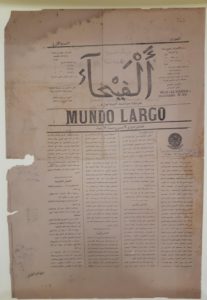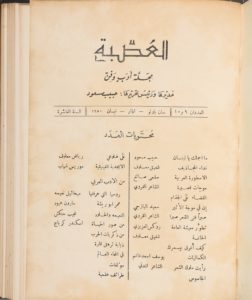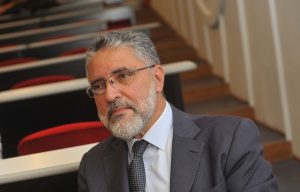São Paulo – How did the first Arabs who migrated to Brazil live, how did they think, how did they feel in the country that welcomed them, and how did they miss the land they had left behind? Getting this information directly from these immigrants is now possible thanks to a project carried out by Lebanon’s Holy Spirit University of Kaslik (USEK) that has partnered up with Brazil’s Arab Brazilian Chamber of Commerce (ABCC).

After three years of work, the Digitization Project of the Memory of Arab Immigration in Brazil has completed its first phase and makes available access to the first 100,000 digitized pieces. They are books pages, magazines, journals and pictures made by the Arab immigrants in the late nineteenth and early twentieth century and are made available digitally. You can read the accounts and thoughts of the immigrants of the time.
The electronic link to access the material collected by the project will be formally launched on Saturday (26) in an event at the Immigration Museum in São Paulo celebrating the Day of the Arab Community in Brazil, whose official date is March 25. “It’s a present we’re giving to the Arab community,” ABCC Cultural director Silvia Antibas told ANBA.
The Digitization Project of the Memory of Arab Immigration in Brazil aims to preserve the memory of Arab immigration, not letting it get lost or depend on the conservation of physical documents. Many materials will be gathered in the digital environment, without the need to visit different libraries, institutions or cities to find them. The intention is that the pieces help the work of future researchers.
The materials selected to be digitized include the 1893’s newspaper Al Fayha, which was called “Mundo Largo” [“Large world”] in Portuguese, published in Campinas, São Paulo. “It’s the first Arabic newspaper published in Brazil. And not just in Brazil but in Latin America as a whole,” says Brazilian researcher and historian Roberto Khatlab, director of the Latin American Studies and Cultures Center (CECAL) at USEK.
From Lebanon to Latin America

It all began at USEK. The Digitization Project of the Memory of Arab Immigration in Brazil was part of a larger project by the university to gather and digitize the memory of the Arab immigrants, particularly Syrian and Lebanese, in Latin America. First, they created a brick-and-mortar library in the region and then the digital library began to be developed. The Brazilian documents are part of the Latin America collection, with materials from other countries in the region gathered by USEK’s Project for the Conservation of the Memory of Arab Immigration in Latin America. The Latin American materials are in the USEK’s Special collection and available for consultation.

An agreement between the ABCC and USEK made it possible to implement the idea in Brazil. In other Latin American countries, the university has partnered up with other institutions to take the initiative forward. In Brazil, a team from the Lebanese university provided training so that the research and digitization work was carried out by the ABCC. And so started the fieldwork by locating journals, documents and pictures from private and public institutions, at first in the city of São Paulo, then by selecting what should be digitized.

As per Khatlab’s directions, the project’s coordinator in Brazil, Heloisa Dib, and then-ABCC Documentation Services assistant Mirna Adel Nasser went after the collections’ owners. According to Dib, they worked on the archives of institutions like the ABCC itself, the Institute for Arab Culture (ICArabe), Syrian Sports Club, Clube Homs, Mário de Andrade Library, and Syrian Home Pro Childhood. The team will also receive digitized material from the Public Archive of the State of São Paulo. The Arab-descendant Jafet family photos were made available, too.
Many publications are in Arabic, while others are in Portuguese or both. The people involved in the project believe translations will arise from making the digital archive available. “I’m very excited for people to start translating the stories we’ve only heard of,” Dib says. The coordinator believes the exclusively oral transmission could lead the content to get lost over the years.
A collection of memories
The Digitization Project of the Memory of Arab Immigration in Brazil includes the digitization of the pieces, not their analysis. But Lebanese-descendant and Arabic-speaking Mirna Adel Nasser, who worked on the project until recently, had the chance to read some of the materials. She mentions findings that indicate the materials that researchers and people interested in the topic will find.

A journal that caught her eye was A vinha or Al Carmat, published in the early twentieth century under the leadership of immigrant Salua Salame Atlas. “She was a heavily present, highly pioneering female figure here,” she says. By reading the review, which ran for over 30 years, Nasser noticed the change in the topics covered. The first editions talked about family, but as the years went by, topics like society and politics gained ground.

“Arab communication surged — you can notice that. Everyone was eager to share their thoughts,” Nasser said, adding that they shared opinions about Brazilian and Arab politics. Dib says that many of these journals were founded by political groups that the Arabs had established in Brazil, which they used to make their ideas get across to their countries of origin.
Also a part of the collection is Revista da Liga da Andaluza de Letras Árabes (Al Usba), published by immigrants in the late twentieth century. Khatlab says that the journal was part of the revival of the Arabic language. “Arab authors and intellectuals that couldn’t publish in the Middle East because the Ottoman Empire had forbidden them to, sent papers to the Liga Andaluza,” he explains. According to him, Brazil was one of the bases where they could express knowledge and share the Arabic language.
For further research
The project leaders already envision the fruits the archive can yield for future research on the topic. A historian herself, Antibas believes it’s crucial to give access to original documents so that the history of immigration can be told correctly. “By accessing original documents, we’ll have more information and the chance to have our own interpretation of the history of Arab immigration,” she says.

The work will continue, and the project has no end date, the organizers say. They are open to receiving new suggestions of materials to be digitized and ask those who have the abovementioned journals and others to get in touch to help complete the collections. The transferors will be credited in the documents and get a digital copy, besides retaining their originals.
The electronic link won’t provide direct access to the pieces but the collection catalog. To preserve credits and copyrights, interested parties will have to ask for the documents they want to access and receive them after completing registration. New research arising from the archive should be included in the digital library. “We’re offering tools for the researcher to work with,” Khatlab says.
Much collaboration

Antibas says that establishing the Arab House, the ABCC’s institute for culture and immigration, was still another reason for the Chamber to be part of the initiative. In an interview with ANBA, the project’s team pointed out that many people were essential for setting up the project, including USEK president Georges Hobeika, who has even visited Brazil to sign the agreement with the ABCC, and was followed up by the current president Talal Hachem and the library’s director Joseph Moukarzel.
The project of the memory of immigration started during the Rubens Hannun administration at the ABCC, and it continued under the current administration of president Osmar Chohfi. It featured contributions from director Abel Auada and Marketing vice president Riad Younes, the current board, and former presidents, including supporters and participants.
Launch
The event where the project’s link will be made launched on Saturday will feature several activities in celebration of the Day of the Arab Community in Brazil. Starting at 2:30 pm (BRT), the in-person event will feature lectures and short-film screenings on Arab immigration in the Immigration Museum. On Sunday (27), the play Cartas libanesas [Lebanese letters] will stream online on YouTube. The celebration is carried out in partnership with the ABCC.
Quick facts:
Latin America Collection – Arab Immigration
Holy Spirit University of Kaslik (USEK)
Access the collection catalog here
Consultation: reference@usek.edu.lb
Translated by Guilherme Miranda




